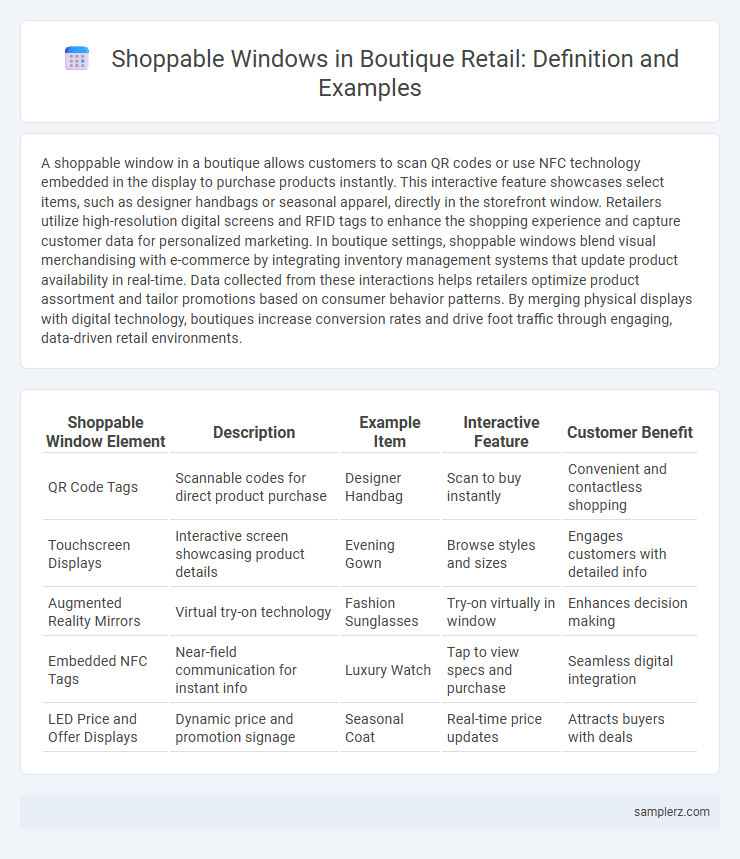A shoppable window in a boutique allows customers to scan QR codes or use NFC technology embedded in the display to purchase products instantly. This interactive feature showcases select items, such as designer handbags or seasonal apparel, directly in the storefront window. Retailers utilize high-resolution digital screens and RFID tags to enhance the shopping experience and capture customer data for personalized marketing. In boutique settings, shoppable windows blend visual merchandising with e-commerce by integrating inventory management systems that update product availability in real-time. Data collected from these interactions helps retailers optimize product assortment and tailor promotions based on consumer behavior patterns. By merging physical displays with digital technology, boutiques increase conversion rates and drive foot traffic through engaging, data-driven retail environments.
Table of Comparison
| Shoppable Window Element | Description | Example Item | Interactive Feature | Customer Benefit |
|---|---|---|---|---|
| QR Code Tags | Scannable codes for direct product purchase | Designer Handbag | Scan to buy instantly | Convenient and contactless shopping |
| Touchscreen Displays | Interactive screen showcasing product details | Evening Gown | Browse styles and sizes | Engages customers with detailed info |
| Augmented Reality Mirrors | Virtual try-on technology | Fashion Sunglasses | Try-on virtually in window | Enhances decision making |
| Embedded NFC Tags | Near-field communication for instant info | Luxury Watch | Tap to view specs and purchase | Seamless digital integration |
| LED Price and Offer Displays | Dynamic price and promotion signage | Seasonal Coat | Real-time price updates | Attracts buyers with deals |
What Is a Shoppable Window?
A shoppable window in a boutique integrates interactive technology, allowing customers to browse, select, and purchase products directly through the store's window display at any time. These digital displays feature QR codes or touchscreen interfaces that enhance customer engagement and streamline the buying process without entering the store. By transforming traditional window displays into e-commerce portals, boutiques increase sales opportunities and provide a seamless omnichannel shopping experience.
Evolution of Window Displays in Retail
Shoppable windows in boutiques have revolutionized retail by transforming traditional displays into interactive, purchase-enabled experiences that engage customers beyond store hours. These displays utilize QR codes, NFC technology, and augmented reality to showcase products, allowing shoppers to browse and buy directly from the window, enhancing convenience and increasing sales. The evolution from static visuals to dynamic, technology-driven installations reflects a broader trend of integrating digital innovation within physical retail environments.
Key Features of Shoppable Windows in Boutiques
Shoppable windows in boutiques feature interactive touchscreens or QR codes that allow customers to browse product details and make purchases directly from the display. These windows integrate real-time inventory updates and personalized recommendations based on shopper preferences, enhancing engagement and convenience. High-resolution digital displays and augmented reality elements enable virtual try-ons, driving increased foot traffic and sales conversion rates.
Technology Powering Shoppable Windows
Shoppable windows in boutique retail are powered by integrated RFID technology and interactive touchscreens enabling customers to scan products and make instant purchases from the display. Advanced AI-driven analytics track consumer engagement and optimize product placements in real-time to enhance shopper experience. Cloud-based inventory management systems ensure seamless updates and availability, bridging the gap between physical storefronts and e-commerce efficiency.
Interactive Elements That Attract Customers
Shoppable windows in boutique retail use interactive touchscreens and QR codes that allow customers to explore product details and make purchases seamlessly. Motion sensors activate dynamic displays and personalized promotions, increasing engagement and dwell time. Augmented reality features enable shoppers to visualize items, enhancing the overall shopping experience and driving higher conversion rates.
Examples of Successful Shoppable Window Campaigns
Burberry's flagship boutique in London implemented a shoppable window campaign featuring interactive LED displays that allowed passersby to browse and purchase items directly from the storefront, boosting online sales by 25%. Gucci integrated RFID technology in its Milan store's shoppable window, enabling customers to tap QR codes and instantly access product details and purchase options, enhancing customer engagement and sales conversion rates. Nordstrom's shoppable window in Seattle utilized augmented reality to showcase entire outfits, resulting in a 30% increase in foot traffic and higher average order values during the campaign period.
Benefits for Boutiques Embracing Shoppable Windows
Shoppable windows in boutiques enhance customer engagement by allowing passersby to browse and purchase products directly through interactive displays, increasing sales without additional foot traffic. These windows provide real-time inventory updates and seamless integration with e-commerce platforms, improving operational efficiency and reducing checkout friction. By leveraging shoppable windows, boutiques build stronger brand visibility and create innovative shopping experiences that differentiate them from traditional retail competitors.
How Shoppable Windows Drive Foot Traffic and Sales
Shoppable windows in boutiques transform traditional displays into interactive shopping experiences where customers can scan QR codes or use NFC technology to purchase items instantly. This innovative approach increases foot traffic by attracting passerby engagement and converting window shoppers into buyers. Retailers report up to a 30% boost in sales attributed directly to shoppable windows, highlighting their effectiveness in blending branding with seamless digital commerce.
Best Practices for Designing Engaging Shoppable Windows
Effective shoppable windows in boutique retail combine clear product visibility with interactive digital elements, allowing customers to browse and purchase items directly from the display. Utilizing high-resolution touchscreens and QR codes facilitates seamless mobile shopping experiences while enhancing customer engagement. Strategic lighting and seasonal themes further attract foot traffic and spotlight key merchandise, increasing conversion rates.
Future Trends in Shoppable Window Displays for Boutiques
Shoppable window displays in boutiques are evolving through the integration of augmented reality and interactive touchscreens, enabling customers to browse and purchase products directly from the display. These futuristic installations often feature smart mirrors and QR code technology, creating a seamless blend of physical and digital shopping experiences. Retailers utilizing AI-driven personalization in shoppable windows anticipate increased customer engagement and higher conversion rates in luxury and niche markets.

example of shoppable window in boutique Infographic
 samplerz.com
samplerz.com